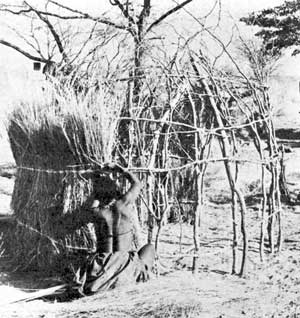Constructing Power
International Symposium 30th of June - 2nd of July 2005 in Heidelberg
|
The "primitive hut" as a purely functional shelter, an artificial cave intended solely to protect against harsh weather and wild animals, is one of architectural history's myths. From the very beginning, architectural space is social space, and since the inception of building, material and ideological dimensions have been interwoven. Ethnological studies like Lorna Marshall's research among the !Kung San of the Kalahari clearly document both the factuality and the inevitability of this interconnectedness. Jeremy Bentham's 18 th century plan for the Panopticon, on the other hand, represents a conscious and calculated effort to preconfigure interhuman relations by means of an architectural structure and thus to bring about certain desired social effects. Regarded by its inventor as equally suited to the purposes of a school building and a mental asylum, a factory building and a prison, this design, which has never been realized, was intended to guarantee the permanent visibility of its inhabitants , thereby establishing control over the individual's actions and power over the individual itself. "Constructing Power" is the subject of a symposium aiming toward an understanding of the architecture of states and other societies from prehistory to the modern day as a vital source of information regarding the social history and sociology of these communities. Reflections on configurative aspects as indicated by the above examples will just as much contribute to this end as considerations of representative aspects of public and state buildings and spatial orders. Discussion will be based on and directed by a conception of these forms of architecture as both documents and preconditions of social realities, as stages for the enactment of the self-image of those in power and arenas for the constant renegotiation of this power, as a medium of codified messages and a means of spatial ordering. |
 |
|
| "Fires are constant, shelters are whims. They sometimes put up two sticks to symbolise the entrance to the shelter, so that the family may orientate itself as to which side is the man's side and which side is the women's side of the fire. Sometimes they do not bother with the sticks.>" (Lorna Marshall) | ||
 |
The broad chronological framework necessitates an interdisciplinary approach which brings into the dialogue perspectives that at first seem contradictory, but are in fact complementary: The contributing academic disciplines will differ in their underlying concepts of space, as either materially "being" or "coming into being" through social action, as well as in their methodological approach to the analysis of space. In the eyes of a sociologist, the built structure, inventories and human actors as levels of analysis will define the use of a room with increasing clarity, while for the archaeologist they represent categories of decreasing visibility. Bridging such disciplinary and methodological rifts between historical and social sciences will constitute one of the major challenges of the symposium. Of course, the metaphor of "bridging" is in itself indicative of the degree to which a practical knowledge of architecture as an ordering structure and signalling medium permeates our language. With regard to power relations this is particularly evident and has a long history : in ancient Egypt, for example, ("Great House") was seen as ordering the fortunes of the world. Based on the evidence of our daily newspapers, we might reach the conclusion that today's "White House" sees itself in pretty much the same role. |
|
| "Morals reformed, health preserved, industry invigorated, instruction diffused, public burthens lightened, economy seated as it were upon a rock, the gordian knot of the poor-laws not cut but untied; all by a simple idea in architecture." (Jeremy Bentham) | ||

